
Vernonia is a genus of about 350 species of forbs and shrubs in the family Asteraceae. Some species are known as ironweed. Some species are edible and of economic value. They are known for having intense purple flowers. The genus is named for the English botanist William Vernon. There have been numerous distinct subgenera and subsections named in this genus, and some botanists have divided the genus into several distinct genera. For instance, the Flora of North America recognizes only about twenty species in Vernoniasensu stricto, seventeen of which are in North America north of Mexico, with the others being found in South America.
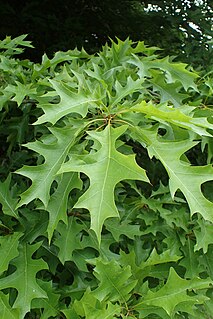
Quercus texana, commonly known as Nuttall's oak, is a fast-growing, large deciduous oak tree.

Arbutus xalapensis, commonly known as the Texas madrone, naked Indian tree or Texas madroño, is a species of flowering plant in the heather family. It is native to Central America, the southwestern United States, and throughout Mexico. It is found in canyons and mountains, on rocky plains, and in oak woodlands, at altitudes of up to 3,000 m in the south of the range, but lower, down to 600 m in the north of the range.

Quercus buckleyi, commonly known as Texas red oak or Buckley's oak, is a species of flowering plant in the beech family. It is endemic to the southern Great Plains of the United States.

Gutierrezia is a genus of flowering plants in the family Asteraceae, native to western North America and western South America. Plants of this genus are known generally as snakeweeds or matchweeds. Some species have been called greasewood. They are annual or perennial plants or subshrubs with yellow or white flowers.
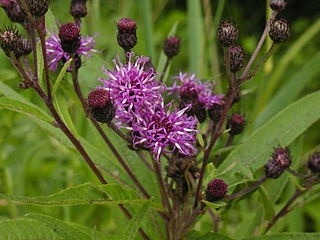
Vernonia noveboracensis is a plant in the daisy family, Asteraceae. It is native to the eastern United States, from Florida to Massachusetts and west to Tennessee, Alabama, and West Virginia and to southern Ontario.

Lygodesmia, called skeletonplant, is a genus of North American flowering plants in the dandelion tribe within the sunflower family.
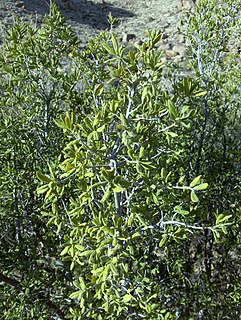
Diospyros texana is a species of persimmon that is native to central, south and west Texas and southwest Oklahoma in the United States, and eastern Chihuahua, Coahuila, Nuevo León, and Tamaulipas in northeastern Mexico. Common names include Texas persimmon, Mexican persimmon and the more ambiguous "black persimmon". It is known in Spanish as chapote, chapote manzano, or chapote prieto, all of which are derived from the Nahuatl word tzapotl. That word also refers to several other fruit-bearing trees.

Salvia texana, commonly called Texas sage, is a species of flowering plant in the mint family (Lamiaceae). It is native to North America, where it is found in northern Mexico, and in the U.S. states of Texas and New Mexico. Its natural habitat is dry areas on limestone soils, in prairies or over rock outcrops.

Quercus mohriana, commonly known as the Mohr oak, shin oak or scrub oak, is a North American evergreen shrub or small tree in the white oak group and is native to the south-central United States and north-central Mexico. The species epithet mohriana honors the pharmacist and botanist Charles Mohr of Alabama.
Gutierrezia texana is a North American species of flowering plant in the family Asteraceae known by the common name Texas snakeweed. It is native to the south-central United States and northern Mexico as far south as Guanajuato and Hidalgo.
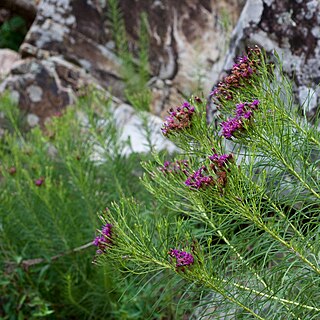
Vernonia lettermannii, the narrowleaf ironweed, is a plant species known only from Arkansas and Oklahoma. It grows on floodplains and terraces at elevations of 100–200 m (330–660 ft).

Berlandiera texana is a North American species of flowering plant in the sunflower family. It is native to the south-central United States, in the states of Texas, New Mexico, Oklahoma, Kansas, Missouri, Arkansas, and Louisiana.
Haploesthes greggii, common name false broomweed, is a North American species of flowering plants in the daisy family. It grows in northeastern Mexico and in the south-central and southwestern United States.

Vernonia baldwinii, the western ironweed or Baldwin's ironweed, is a perennial herb native to central North America.
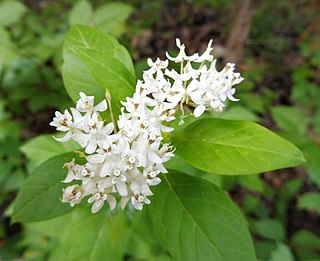
Asclepias texana, commonly called Texas milkweed, is a species of flowering plant in the dogbane family (Apocynaceae). It is native to North America, where it is widespread in the regions of the Chihuahuan Desert and Edwards Plateau. Its range spans from the states of Durango and Coahuilla in Mexico, north to the state of Texas in the United States. Its natural habitat is in dry rocky areas in canyons or along arroyos.

Vernonia lindheimeri, commonly known as woolly ironweed, is a species of flowering plant in the aster family (Asteraceae). It is native North America, where it is native to the state of Coahuila in Mexico and to the state of Texas in the United States. Its natural habitat is in open, calcareous areas.

Stillingia texana, the Texas toothleaf, is a species of flowering plant in the family Euphorbiaceae. It is native to the South Central United States and Mexico. In central Texas it is widespread in upland, calcareous prairies, spreading north to scattered locations in Oklahoma and south to Coahuila. Stillingia texana was described in 1923 by Ivan Murray Johnston.

Hypericum frondosum, the cedarglade St. Johnswort or golden St. John's wort, is a species of flowering plant in the St. John's wort family, Hypericaceae. It is native to the central and southeastern United States in dry, rocky habitats.

Lindheimera texana, commonly known as Texas yellow star, is a species of flowering plant in the sunflower tribe within the daisy family. It is found in the south-western United States and northern Mexico (Coahuila). Other common names include star daisy, Texas star and Lindheimer daisy,


















